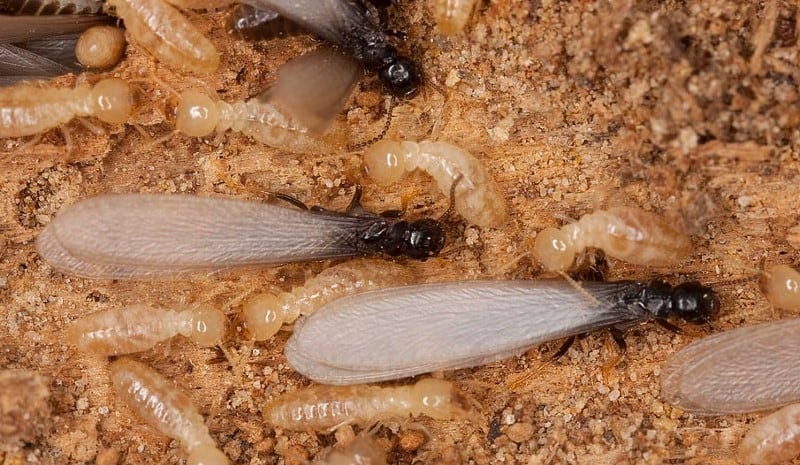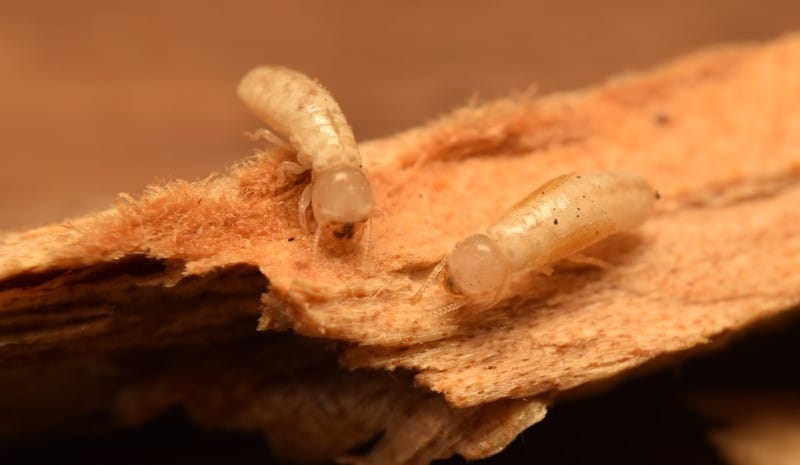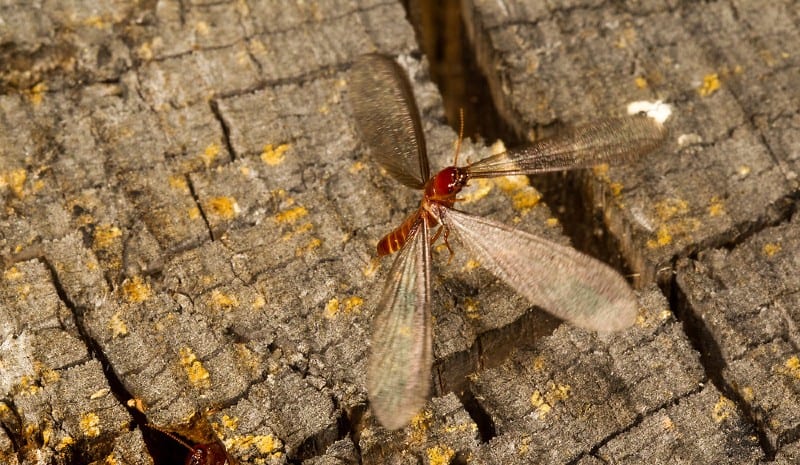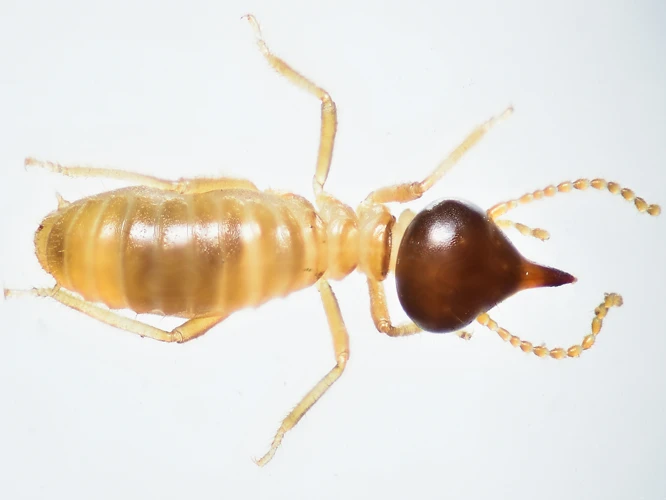Subterranean Termites

Burrowing beneath the ground, these small, social insects are a force to be reckoned with when it comes to property destruction. Subterranean termites go undetected for years as they eat away at the wooden structures of homes, silently causing damage that can become incredibly expensive if left unchecked. In this section, we will explore the physical characteristics of these elusive creatures, including their appearance, behavior, diet, damage potential, and control methods. Don’t forget to check out our article on the role of termites in the ecosystem to learn more about these fascinating insects.
Appearance
When it comes to physical appearance, different types of termites have unique characteristics. Knowing the differences can help homeowners identify which species they are dealing with and how to best prevent or control the infestation. Here are some of the appearance characteristics of few common types of termites:
- Size: Workers measure around ¼ to ⅜ inch in length. Soldier termites are about the same size, while reproductive swarmers can be up to ⅜ inch long.
- Color: They are usually pale yellow or brownish in color.
- Body: Subterranean termites have soft bodies, straight antennae, and a straight waist. They also have four wings with a few conspicuous veins.
Although the physical appearance of termites can vary, they all have some similarities, including a soft, white body, straight antennae, and wings. While identifying appearance characteristics is helpful in determining which type of termite is present in the home, it is only one aspect of a thorough termite inspection. For more information about termite behavior and biology, check out our articles on termite communication, signs of termite infestation, and subterranean termite mating.
Behavior
Termites can be divided into different groups based on their behavior, and understanding their behavior is essential for controlling and preventing their damage. Here are some behaviors specific to each type of termite:
– Live in colonies underground and build mud tubes or shelter tubes to access above-ground food sources
– Swarmers, or reproductive termites, use their wings to fly out of their colony and establish new colonies
– Are very social and rely on pheromones to communicate with each other and coordinate their activities
Diet
Subterranean termites eat anything containing cellulose, which includes wood, plant fibers, paper, cardboard, and even insulation. They are primarily drawn to moist and decaying wood. They will consume hardwoods and softwoods, but are more attracted to softwoods due to their high levels of cellulose. In addition to cellulose, they also require a certain set of protozoa, bacteria, and fungal organisms in their gut to help digest nutrients from the wood. It is also worth noting that subterranean termites cannot digest concrete or plastic, but they can easily squeeze through small cracks and crevices in search of sources of cellulose.
Damage
Termites are notorious for causing significant damage to homes and other wooden structures. The extent of the damage depends on the type of termite infestation and the length of time the infestation has gone unnoticed.
These termites damage wood from the inside out, making it difficult to identify an infestation until it’s too late. They build mud tunnels to access wood above ground, which is why they’re commonly found in basements and crawl spaces. The damage caused by subterranean termites can weaken the structural integrity of a building and can result in costly repairs.
Prevention and Control
When it comes to preventing and controlling termite infestations, there are multiple steps homeowners can take depending on the type of termite.
Subterranean Termites:
- Remove any wood, debris, or cellulose materials from around the foundation perimeter of the home.
- Ensure that air conditioning units don’t have leaks which could create a damp environment that attracts termites.
- Use a liquid termite barrier around the foundation perimeter of the home to create a barrier that repels termites.
- Install physical barriers, such as a metal mesh or sand barrier, to prevent termites from accessing the wood structure of the home.
Drywood Termites

When it comes to wood-dwelling pests, drywood termites are often a top concern for homeowners. These hardy insects can infest dry wood structures, including furniture, baseboards, and framing. And since drywood termites live entirely within their infested wood, they can often go undetected for extended periods, leading to significant damage. In this section, we’ll cover the physical characteristics of drywood termites, their behavior, diet, and methods for prevention and control.
Appearance
When it comes to the appearance of different types of termites, there are some unique physical characteristics that set them apart. Let’s take a closer look:
- Drywood termites are typically a light brown or cream color, with bodies ranging from 1/4 to 3/8 inch in length.
- They have large, round heads and short, thick antennae.
- Unlike subterranean termites, drywood termites do not require contact with soil and instead live within the wood they infest.
Behavior
Termites are known for their unique behavior, which varies depending on the type of termite.
- Drywood termites live in dry wood, and they do not need contact with soil or moisture. They typically swarm in late summer and early fall, during peak temperatures and humidity.
- They can go undetected for years, as they do not create mud tubes like subterranean termites. However, once a colony is established, it can cause substantial damage to a building’s structural components.
- Drywood termites are known for their ability to spread quickly, making early detection and treatment crucial for preventing major damage.
Diet
Drywood termites, on the other hand, prefer to feed on hardwoods and are commonly found in furniture, frames, and flooring. They can also invade structural timbers, but tend to do less overall damage than subterranean termites because they live in smaller colonies. Drywood termites can survive with very little moisture, so they can easily infest dry wood structures. They can even live off the moisture from the wood they consume, which allows them to survive without returning to the soil for their water supply.
Damage
Drywood termites, on the other hand, tend to infest and damage exposed wood. They can create galleries inside the wood, leaving behind layers of damaged and weakened material that reduces the structural integrity of the wood. This can lead to sagging floors, walls, and ceilings.
It is important to note that all types of termites can cause extensive damage if left untreated. It is crucial to identify and treat a termite infestation as soon as possible to prevent further damage. Regular inspections and preventative measures can help mitigate the risk of a termite infestation in a home or building.
Prevention and Control
When it comes to preventing and controlling termite infestations, there are multiple steps homeowners can take depending on the type of termite.
Drywood Termites:
- Seal any cracks or gaps in the home’s exterior to prevent termites from entering.
- Install screens on windows to prevent termites from entering the home.
- Use a non-repellent termiticide to create a barrier around the perimeter of the home preventing termites from entering.
- Remove any infested wood through fumigation, heat treatment or spot treatment with pesticides.
Dampwood Termites

As we explore the different types of termites, another species that deserves attention is the dampwood termite. These insects have unique characteristics that distinguish them from other termite species. While they may not be as prevalent as the subterranean or drywood termites, dampwood termites are still a concern for homeowners, especially those living in areas with high humidity or moisture. Let’s take a closer look at the physical characteristics, behavior, diet, damage, prevention, and control of dampwood termites.
Appearance
Termites are often mistaken for ants due to their similar size and shape, but upon closer inspection, their appearance is distinct. In this section, we will explore the physical characteristics that differentiate each termite type.
Size: They are larger than both subterranean and drywood termites, with workers measuring up to ¾ inch long and soldiers measuring around ⅜ inch long. Swarmers are up to 1 inch long.
Color: They are usually brownish in color.
Body: Dampwood termites have elongated, narrow bodies and curved antennae. They have two pairs of wings, but the front pair is longer than the hind pair.
Behavior
Dampwood Termites, as their name suggests, require a damp environment to survive. They build their nests in high-moisture areas such as decaying wood or damp soil. These termites have an interesting behavior of swarming during the fall season to mate and form new colonies.
Understanding the behavior of different types of termites is crucial for prevention and control. By knowing what to look for and how they behave, homeowners can take proactive steps to protect their property from termite damage.
Diet
Dampwood termites mostly feed on damp and decaying wood, such as fallen and rotting logs. They are also known to invade wooden structures that have high levels of moisture. Dampwood termites are unique because they can digest wood that is not as rich in cellulose as other termites, which allows them to thrive in wet environments. They do not usually infest homes and buildings, but if the wood in your home is moist enough, dampwood termites could be a problem.
Damage
Dampwood Termites: These termites are attracted to damp and decaying wood and are typically found in areas with high moisture levels. Their presence can be an indication of other moisture problems in a home. They can cause significant damage to the structural integrity of a building and can lead to weakened beams and floorboards if left untreated.
Prevention and Control
Dampwood Termites:
- Fix any leaking pipes or faucets to create a less ideal environment for termites.
- Ensure that gutters are clean and downspouts are well-positioned to avoid moisture accumulation.
- Make sure there is proper ventilation in crawlspaces or attics to avoid damp conditions.
- Replace any infested wood with insect-resistant wood or with a synthetic alternative
Conehead Termites

It’s a bird! It’s a plane! No, it’s a swarm of conehead termites! These unique termites are often mistaken for ants due to their narrow waists, but their physical characteristics and behaviors set them apart from their look-alikes. Let’s take a closer look at the appearance, behavior, diet, damage potential, prevention, and control methods for these intriguing insects.
Appearance
Conehead termites are so named because of the shape of their heads, which are elongated and pointed.
They are usually a light to medium brown color and have an elongated body with antennae that are straight and segmented.
Unlike subterranean termites, conehead termites do not require contact with soil and are able to live outside of it.
Behavior
Conehead termites are an invasive species originally from the Caribbean. They are named for the conical shape of the heads of their soldiers.
They are social insects that live in large colonies, often located above ground in trees or wooden structures such as homes and buildings.
Conehead termites are highly destructive and aggressive, often chewing through structural components quickly. They are known for their behavior of building “carton nests” made of saliva and fecal matter, which can be an indication of an infestation.
Diet
Conehead termites have a diverse diet, eating both rotting and new wood. They are also known to consume plants, including living trees, which sets them apart from other species of termites. They have been known to chew through plastic and even thin sheets of metal to gain access to a food source. Conehead termites live in expansive colonies with multiple queens, and they can cause significant damage in a short amount of time.
Damage
Conehead termites can cause extensive damage to wooden structures and landscaping. They can also infest non-wood items, such as wiring, insulation, and foam board used in construction. They can cause damage to trees, shrubs, and other types of vegetation, leading to significant landscape damage.
Prevention and Control
Since conehead termites tend to nest in the soil, it’s important to treat the soil around the foundation perimeter of the home with a termiticide.
Use a physical barrier around the perimeter of the home, such as a metal mesh or sand barrier, to prevent termites from entering the home.
Remove any wood or debris from the soil around the home’s foundation.
Consider using termite-resistant building materials when making new additions to the home or remodeling.
Formosan Termites
Formosan termites are a type of subterranean termite that are known for their destructive capabilities and resilience. Commonly found in warm, humid climates, they are a serious threat to structures made of wood. Known to cause significant damage in a short amount of time, they can be difficult to control and eradicate. It is important to understand the physical characteristics of Formosan termites in order to take the necessary steps to prevent and control infestations. Let’s explore the unique attributes of these formidable pests.
Appearance
Formosan termites are a yellowish-brown color and are approximately 1/2 inch in length.
They have oval-shaped bodies and straight antennae that have a bead-like appearance.
Their soldiers have elongated heads with mandibles that are used for defense.
Behavior
Formosan Termites:
- Formosan termites are an invasive species originally from China. They are now found in many parts of the world, including the southeastern United States.
- They are a highly social insect that lives in underground colonies of up to 10 million individuals. They are also very aggressive and are known for attacking other termite colonies and even plants.
- Formosan termites are considered one of the most destructive termite species as they can cause significant damage to buildings and structures in a short amount of time.
Diet
Formosan termites are notorious for their ability to consume wood and other materials that are not typically considered a food source for termites. They have even been known to chew through plaster, asphalt, and thin sheets of metal. Formosan termites require more water than other species, so they are commonly found in areas with high humidity or moisture, or near water sources. They are very aggressive and can cause major structural damage in a matter of months. It is crucial to catch an infestation early on and take measures to prevent further damage.
Damage
Formosan termites are known to cause severe damage in a short period. The sheer number of individuals in a colony, coupled with their voracious appetites, can lead to substantial structural damage in as little as six months. They can consume structural timbers, flooring, and even electrical insulation.
Prevention and Control
Formosan Termites:
- Since formosan termites’ colonies can be quite extensive and difficult to locate, professional extermination and monitoring is often recommended.
- If building a new home, consider using termite-resistant building materials and design features, such as concrete foundations.
- Remove any moisture sources around the home, such as leaky pipes or poor drainage systems, to avoid attracting termites to the area.
- Regularly inspect wooden structures around the home for any signs of termite activity.
Conclusion
After learning about the physical characteristics, behaviors, diets, damages, prevention, and control measures of different types of termites, it becomes clear that these tiny creatures can cause significant damage to both residential and commercial properties.
Prevention is the key to avoiding costly repairs and ensuring the safety of the building’s occupants. The most effective way to prevent termite infestations is to schedule regular inspections with a professional pest control service. Additionally, homeowners and property managers should eliminate sources of moisture and wood decay, seal all cracks and crevices in the foundation and walls, and avoid storing wood or cellulose-based materials near the building.
Control measures for existing termite infestations depend on the type and severity of the infestation. Treatment options include chemical sprays, baits, and physical barriers. Homeowners and property managers should consult with a licensed pest control professional to determine the most effective and safe treatment plan for their specific situation.
It is important to note that attempting to control a termite infestation without professional assistance can be dangerous and ineffective. Termites are highly resilient insects that require specialized knowledge and equipment to eradicate completely. Hiring a licenced pest control company ensures the safety of both the occupants and the building and can prevent costly damage in the long run.
In conclusion, understanding the physical characteristics, behaviors, diets, damages, prevention, and control measures of different types of termites is crucial for protecting buildings from these destructive insects. Taking preventative measures and consulting with a licensed pest control professional can save property owners considerable time, money, and stress in the future.
Frequently Asked Questions
What do subterranean termites look like?
Subterranean termites are small in size, around 1/8 to 3/8 inches long, and are typically pale or light brown in color. They have straight antennae and a broad waist.
Do termites eat through concrete?
No, termites cannot eat through concrete, but they can get through tiny cracks and gaps that may exist in concrete foundations and walls.
Can drywood termites fly?
Yes, drywood termites have wings and can fly, but they usually stay close to their nesting area, unlike subterranean termites that fly away for new colonies.
What type of wood do dampwood termites prefer?
Dampwood termites prefer to nest in and feed on moist, decaying wood, as this provides them with the necessary amount of moisture they require.
Where are conehead termites typically found?
Conehead termites are typically found in South Florida, the Caribbean, and certain parts of South America.
How can you tell if you have a termite infestation?
You may notice small holes in your wood, mud tubes on your walls or foundation, or discarded wings around your home. If you suspect an infestation, it’s important to call a professional termite inspector for an accurate assessment.
Can termites cause structural damage?
Yes, termites can cause significant structural damage to a home if left untreated. They can weaken wood structures and even cause a building to collapse in severe cases.
What is the difference between swarmers and workers?
Swarmers are reproductive termites that have wings and are responsible for starting new colonies. Workers are non-reproductive termites that do the majority of the damage as they feed on wood and expand the colony.
How do you prevent a termite infestation?
You can prevent a termite infestation by eliminating moisture around your home, avoiding wood-to-soil contact, sealing any cracks or gaps in your foundation, and regularly inspecting for signs of termite activity.
Can you treat a termite infestation yourself?
While DIY treatments may provide temporary relief, it’s important to contact a professional termite exterminator for a thorough treatment and ongoing preventative measures to ensure the infestation does not return.

